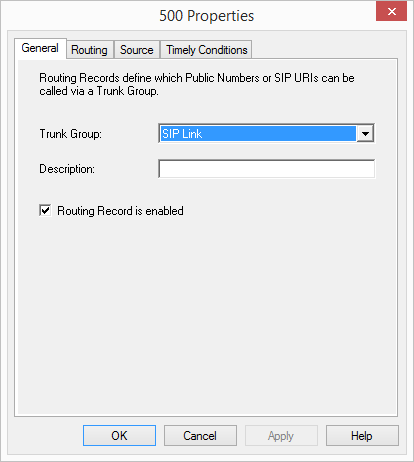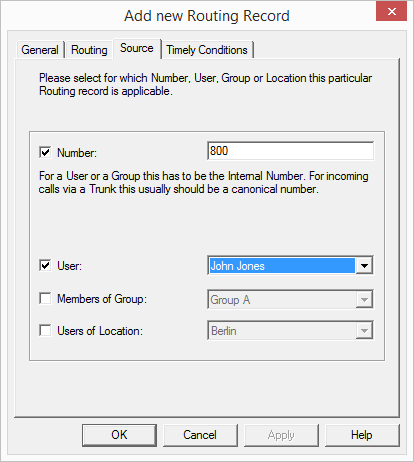14.1 Routing configuration
A routing is always assigned to a specific trunk group, so that it is effectively a property of this trunk group. Rules are created based on the dialed destination numbers, and placeholders can be used. The routing can be formulated positively (Use this Trunk Group for Calls to the following) or negatively (Do not use this Trunk Group for Calls to the following). The routing records can be prioritized. A sequence order can thus be defined within the routings, e.g. "Try first on trunk group A, then on trunk group B". The caller number of the calling SwyxWare user, the group membership or the user's location can be taken into account in the decision on which trunk group is selected.
For SwyxLink trunks with configured intersite settings a routing record is created automatically. This entry is not editable.
If the trunk group consists of several trunks, the trunk with this number is selected. (e.g. Public numbers of this trunk). If no trunk matching the caller number is found within the selected trunk group, the trunk signaling the most information about the caller is selected. The number signaled externally arises according to the valid setting on this trunk in the field "Outgoing calls if Calling Party Number / URI is not assigned".
Example:
You have two ISDN connections e.g. each with five MSNs. For each of these connections you set up a trunk group:
- User A has an internal number, for which there is a call number mapping to trunk group 1,
- User B has an internal number, for which there is a call number mapping to trunk group 2.
- There are routing records for both trunk groups with the same priority and the same destination number range.
If one of these users calls an external number, then a trunk group is selected using the dialed number and the priority. If these criteria do not lead to a preferred trunk group, the trunk group is randomly selected, i.e. also trunk group 1 can be selected for user 2. If e.g. Hide Number is configured on the trunk groups for unassigned caller numbers, then - without the user intending this - his number is displayed on one call and not on another. To prevent this, when the trunks are similar you can manage both in one trunk group, regardless of the fact that two different ISDN connections are represented.
Routing Records and selection prefix for trunk groups
If a user defines which trunk group should be used for the next call by using the assigned selection prefix, no further routing records are applied.
This is how you define a route
The "General" Tab

Specify on this tab the trunk group to which this record type should apply. You can also insert a short description here.
Trunk Group
Each entry in the forwarding table applies to exactly one trunk group. When a newly created entry is closed with "OK", it is applied immediately for the trunk group for which it was configured. You can only specify a route for an existing trunk group; select an available trunk group from the selection list.
If the record type should not be active at the time, deactivate the checkbox "Routing Record is enabled".
The "Routing" Tab

Specify on this tab the forwarding criteria to be used in relation to the number or URI.
Usage
Activate "Use this Trunk Group for Calls to the following" if you want to forward calls over these trunks which meet the following conditions.
Give the public numbers or URI that should go over this trunk. You can use placeholders here (10.5 Placeholder).
In the field "With additional Prefix", you have several options:
In this case, no further prefix (Call-by-Call provider selection) is added to the destination number.
Enter directly into the field a numerical sequence, which is then prefixed to every destination number that is routed via this trunk group, e.g. "01013".
Specify how often a connection attempt should be repeated (standard: 0). If LCR is not used, but instead the call by call prefix of an economical but heavily overloaded provider is dialed directly, these repeats can be useful in order to try this least expensive provider a number of times.
Activate "Do not use this Trunk Group for Calls to the following" if you don't want to send calls with certain destinations via this trunk group.
For each routing record, you can allow or deny only one type of condition.
Example of the use of placeholders:
If you want to allow only external numbers for a trunk group, then you must enter the following:
Record Priority
Specify the priority with which this forwarding is applied to a call. You can decide a priority between 0 (low) and 1000 (high).
The "Source" Tab

You can say on this tab whether the origin of the call is used for making a decision. If nothing is configured, the routing rule applies to all calls.
Phone number
You can enter an internal number or URI here. The routing rule then applies to all calls which signal this number or URI (internal SwyxWare user or group). If calls coming over this trunk are to be forwarded according to this rule, enter the number or URI here in canonical format. The number is matched from the beginning onward. Enter here e.g.: "21", the routing rule applies to all callers, whose number starts with a "21", see 10.5 Placeholder.
User, Members of Group and Users of Location
You can use further selection criteria here. This rule can be set for a particular SwyxWare user or for the members of a group. Belonging to a location can also be a selection criterion. You can also combine the two criteria "Members of Group" and "Users of Location" (e.g. All users of the "Support" group at the "Munich" location). The criterion "Number" can equally be combined with the other criteria (User, Members of Group and Users of Location). In combinations, both criteria must be satisfied (logical AND).
The "Timely Conditions" Tab

On this tab you specify time-related conditions (weekdays, time of day) for a routing. You can give both weekdays and also times on the defined weekdays.
Use Routing Record on specific Day(s)
If you want to set up the route dependent on days of the week, activate the checkbox "Use Routing Record on specific Day(s)". Then activate the checkboxes of the weekdays for which this route should apply.
Use Routing Record on specific Time of Day
If you want to set up the route dependent on a time of day, activate the checkbox "Use Routing Record on specific Time of Day". Then specify a period for which this route should be active.